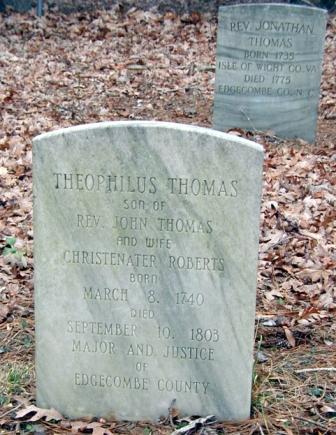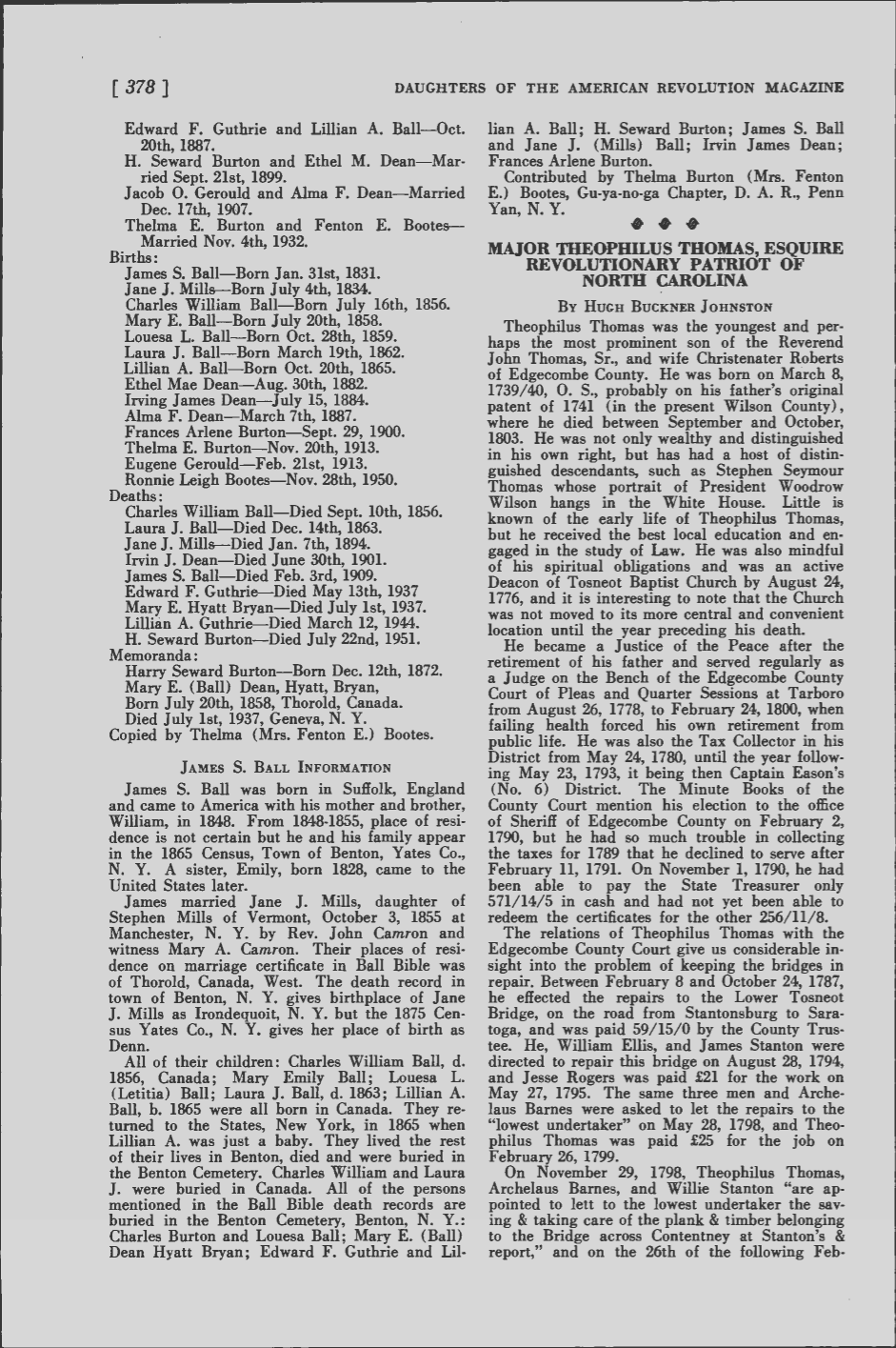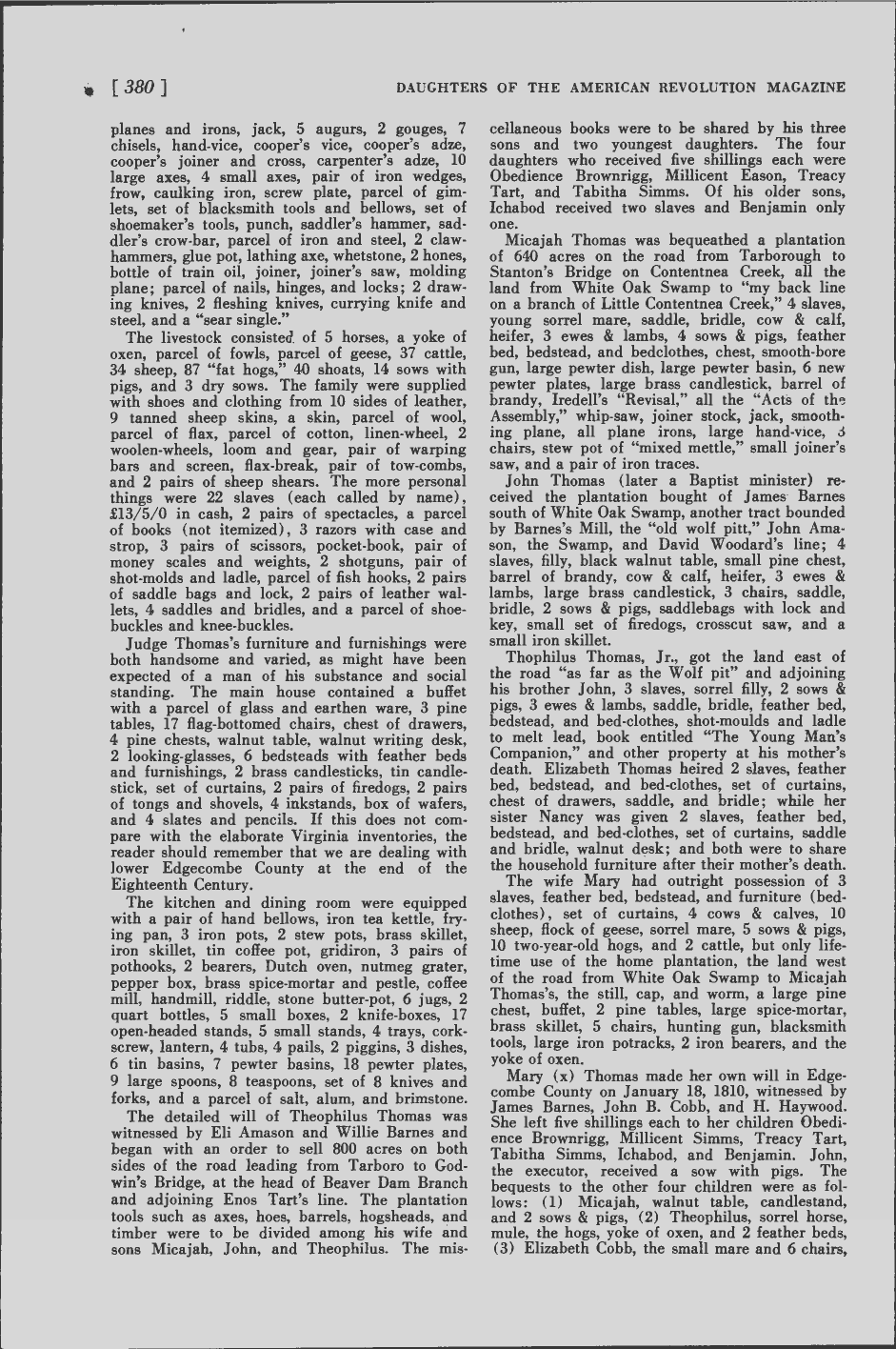Major Theophilus Thomas
Major Theophilus Thomas
I recently found a biography of , my great-great-great-great-great grandfather, in the April 1956 issue of the Daughters of the American Revolution Magazine. The DAR Magazine has lots of biographical sketches written by descendants, but it is largely not indexed. Luckily, I came across the citation through a google books search and then tracked down the issue on the DAR website. The biography was written by Hugh Buckner Johnston, a Wilson, North Carolina based genealogist who features prominently in all Thomas family genealogies of note that I have come across. He died on July 26th, 1990 and is buried in Wilson County.
I’ve reproduced the biography here. The original is viewable on page 378 of the DAR Magazine, which you can find in the above link.
MAJOR THEOPHILUS THOMAS, esquire
REVOLUTIONARY PATRIOT OF NORTH CAROLINA

By Hugh Buckner Johnston
Theophilus Thomas was the youngest and perhaps the most prominent son of the Reverend John Thomas, Sr., and wife Christenater Roberts of Edgecombe County. He was born on March 8, 1739/40, O. S., probably on his father’s original patent of 1741 (in the present Wilson County), where he died between September and October, 1803. He was not only wealthy and distinguished in his own right, but has had a host of distinguished descendants, such as Stephen Seymour Thomas whose portrait of President Woodrow Wilson hangs in the White House. Little is known of the early life of Theophilus Thomas, but he received the best local education and engaged in the study of Law. He was also mindful of his spiritual obligations and was an active Deacon of Tosneot Baptist Church by August 24, 1776, and it is interesting to note that the Church was not moved to its more central and convenient location until the year preceding his death.
He became a Justice of the Peace after the retirement of his father and served regularly as a Judge on the Bench of the Edgecombe County Court of Pleas and Quarter Sessions at Tarboro from August 26, 1778, to February 24, 1800, when failing health forced his own retirement from public life. He was also the Tax Collector in his District from May 24, 1780, until the year following May 23, 1793, it being then Captain Eason’s (No. 6) District. The Minute Books of the County Court mention his election to the office of Sheriff of Edgecombe County on February 2, 1790, but he had so much trouble in collecting the taxes for 1789 that he declined to serve after February 11, 1791. On November 1, 1790, he had been able to pay the State Treasurer only 571/14/5 in cash and had not yet been able to redeem the certificates for the other 256/11/8.
The relations of Theophilus Thomas with the Edgecombe County Court give us considerable insight into the problem of keeping the bridges in repair, Between February 8 and October 24, 1787, he effected the repairs to the Lower Tosneot Bridge, on the road from Stantonsburg to Saratoga, and was paid 59/15/0 by the County Trustee. He, William Ellis, and James Stanton were directed to repair this bridge on August 28, 1794, and Jesse Rogers was paid £21 for the work on May 27, 1795. The same three men and Archelaus Barnes were asked to let the repairs to the “lowest undertaker” on May 28, 1798, and Theophilus Thomas was paid £25 for the job on February 26th, 1799.
On November 29, 1798, Theophilus Thomas, Archelaus Barnes, and Willie Stanton “are appointed to let to the lowest undertaker the saving & taking care of the plank & timber belonging to the Bridge across Contentney at Stanton’s & report,” and on the 26th of the following February, Willie Stanton was paid £6 by the County Trustee “for securing the old plank belonging to the Bridge over Contentney at his house.” There must have been some heavy rains that summer, because on August 27, 1799, Theophilus Thomas and William Ellis, Esquires, were appointed Commissioners to act with the Commissioners from Wayne County in building a new bridge at Willie Stanton’s and to make a report at the next meeting of the Court. This was the bridge now known as Stantonsburg Bridge.
On February 11, 1785, a committee was named “to lay off a Road leading from Tarborough to the … upon Tosneot Bridge by the Meeting House, crossing the White Oak at or near Theophilus Thomas’s into the road by Isaac Eason’s to. Martinborough and that Theophilus Thomas, Esqr. attend the said Jury and is appointed Overseer of said Road.” On November 9, 1785, Henry Robinson was made Overseer of the work of his own hands and those of Ephraim Barnes, Mary Thomas (widow of Jonathan Thomas), and Nathan Tart to “open the new Road leading across the White Oak swamp near Theophilus Thomas’s, beginning at the Road near the Meeting House and to work thro’ the sd. White Oak swamp.”

On February 7, 1786, the hands of William Ellis and Henry Robertson were instructed to “make a Bridge over White Oak Swamp where the new Road Crosses near Theophilus Thomas’s” under the direction of Theophilus Thomas and others. The latter was commissioned to build a bridge over White Oak Swamp on August 31, 1791, and was paid £26/15/0 for his work on November 27, 1792. Theophilus Thomas, Jacob Horn, William Amason, George Brownrigg, and Eli Amason were ordered to repair this bridge on May 27, 1800, and we find that his sons continued to participate in such activities in their community for many years after their father’s death, before they sold out and moved South.
It is not known exactly when Theophilus Thomas became the Captain of a Militia Company of Edgecomb County, but he was actively engaged in the Revolutionary Period. In June, 1781, less than a month after the passage of the British Army under General Cornwallis through Wayne and Edgecombe Counties on his route to Virginia, Captain Thomas marched a Company of three-month draftees from lower Edgecombe County to the Town of Halifax, where some of his men were turned over to Captain Benjamin Coleman of the United States Continental Line for service against the Tories along the Cape Fear River. He seems to have been promoted to Second Major of the Edgecombe County Militia Regiment in 1785; and on January 4, 1787, the General Assembly of North Carolina approved the recommendation of Members Elisha Battle and Etheldred Phillips that he be appointed First Major, a Commission that he held until his resignation in 1795.
When William Attmore, a Philadelphia merchant, took tea at Richard Blackledge’s home in Tarboro on December 23, 1787, he noted in his diary that a Colonel Thomas was one of the gentlemen present. Since we know that frequent business and social events required the presence of Major Theophilus Thomas at the County Seat, we have reason to believe that this was an early example of the polite Southern exaggeration of military titles. However, it should be noted that a Colonel Thomas was paid £16/10/0 for fifty-five bushels of corn (No. 20) and six head of cattle (No. 75) by the United States Comptroller’s Office in Kingston (Kinston) after the Revolutionary War; and Green Hill, Treasurer of the Halifax Military District, paid a number of claims presented by Theophilus Thomas: £10/2/6 (No. 294); £160/0/0 (No. 49), and £23/12/6 (No. 254) in 1783.
Judge Thomas patented 3068 acres of land from the State of North Carolina (including 150 in Wayne County), bought 1,360, and received 790 from his father, making a total of 5,218 acres, and at the time of his death possessed all of it excepting 1,250 acres, of which 1,100 had been deeded to two of his sons. The Edgecombe County Census of 1790 listed him with 8 males, 5 females, and 21 slaves in his family; and in 1800 there were 3 males 10/16, one male over 45, 2 females under 20, one female over forty-five, and 19 slaves. He also owned a tremendous amount of personal property of all sorts, which was listed partly in his nine-page will dated June 25 and probated on November 29, 1803, and more completely in the Inventory made by his sons Ichabod and Micajah Thomas and presented to the Edgecombe County Court in February of 1804.
About 1770 Judge Thomas had married Mary Rogers (October 12, 1756 - March or April, 1810), daughter of Thomas and Mary Rogers of Nash County. They had eleven children: (1) Obedience, November 29, 1771, married Elnathan Tart and later George Brownrigg, (2) Millicent, born April 28, 1773, married James Tart and later John Eason, (3) Ichabod, November 8, 1774, married Susannah Barnes, (4) Benjamin, April 16, 1778, married Mary Dickinson, (5) Theresa, April 25, 1780, married Enos Tart, (6) Tabitha, August 7, 1782, married Benjamin Simms, (7) Micajah, May 26, 1785, (8) John Rogers, September 20, 1787, married Mary Hooker, (9) Theophilus, Jr, May 25, 1790, (10) Elizabeth, November 17, 1793, married John B. Cobb, and (11) Nancy, August 1, 1797, married a Pope.
For his farming operations, Major Thomas employed the following implements: 2 scythes, 2 reaphooks, pair of cart wheels, 4 plow frames, 4 caters 5 fluke hoes, 14 weeding hoes, 4 grubbing hoes, garden hoe, grid hoe, 2 steel traps, pair of iron traces, pair of leather traces, parcel of plow-gear, parcel of baskets, 2 pairs of horse-hames, 2 pairs of steelyards, 2 cart saddles, parcel of horse bells; parcel of peas, beans, corn, and fodder; parcel of timber for cart wheels, etc. and a parcel of band buckles and bridle buckles. He must have had a considerable apple orchard to make use of an apple mill; still kettle, cap, and worm; 24 cider casks, brandy cask, rundlet, bung-borer, 2 wooden funnels, tin funnel, and a parcel of plank for making barrels. He had three full casks of cider on hand at the time of his death, and also a little over seven barrels of brandy, which seemingly represented a twelve-month supply for private and public entertainment.
The list of tools was even more impressive: 2 hand-saws, crosscut saw, whip-saw and box, 2 saw-sets, iron square and compass, 2 smoothing planes and irons, jack, 5 augurs, 2 gouges, 7 chisels, hand-vice, cooper’s vice, cooper’s adze, cooper’s joiner and cross, carpenter’s adze, 10 large axes, 4 small axes, pair of iron wedges, frow, caulking iron, screw plate, parcel of gimlets, set of blacksmith tools and bellows, set of shoemaker’s tools, punch, saddler’s hammer, saddler’s crow-bar, parcel of iron and steel, 2 clawhammers, glue pot, lathing axe, whetstone, 2 hones, bottle of train oil, joiner, joiner’s saw, molding plane; parcel of nails, hinges, and locks; 2 drawing knives, 2 fleshing knives, currying knife and steel, and a “sear single.”
The livestock consisted. of 5 horses, a yoke of oxen, parcel of fowls, parcel of geese, 37 cattle, 34 sheep, 87 “fat hogs,” 40 shoats, 14 sows with pigs, and 3 dry sows. The family were supplied with shoes and clothing from 10 sides of leather, 9 tanned sheep skins, a skin, parcel of wool, parcel of flax, parcel of cotton, linen-wheel, 2 woolen-wheels, loom and gear, pair of warping bars and screen, flax-break, pair of tow-combs, and 2 pairs of sheep shears. The more personal things were 22 slaves (each called by name), £13/5/0 in cash, 2 pairs of spectacles, a parcel of books (not itemized), 3 razors with case and strop, 3 pairs of scissors, pocket-book, pair of money scales and weights, 2 shotguns, pair of shot-molds and ladle, parcel of fish hooks, 2 pairs of saddle bags and lock, 2 pairs of leather wallets, 4 saddles and bridles, and a parcel of shoebuckles and knee-buckles.
Judge Thomas’s furniture and furnishings were both handsome and varied, as might have been expected of a man of his substance and social standing. The main house contained a buffet with a parcel of glass and earthen ware, 3 pine tables, 17 flag-bottomed chairs, chest of drawers, 4 pine chests, walnut table, walnut writing desk, 2 looking-glasses, 6 bedsteads with feather beds and furnishings, 2 brass candlesticks, tin candlestick, set of curtains, 2 pairs of firedogs, 2 pairs of tongs and shovels, 4 inkstands, box of wafers, and 4 slates and pencils. If this does not compare with the elaborate Virginia inventories, the reader should remember that we are dealing with lower Edgecombe County at the end of the Eighteenth Century.
‘The kitchen and dining room were equipped with a pair of hand bellows, iron tea kettle, frying pan, 3 iron pots, 2 stew pots, brass skillet, iron skillet, tin coffee pot, gridiron, 3 pairs of pothooks, 2 bearers, Dutch oven, nutmeg grater, pepper box, brass spice-mortar and pestle, coffee mill, handmill, riddle, stone butter-pot, 6 jugs, 2 quart bottles, 5 small boxes, 2 knife-boxes, 17 open-headed stands, 5 small stands, 4 trays, corkscrew, lantern, 4 tubs, 4 pails, 2 piggins, 3 dishes, 6 tin basins, 7 pewter basins, 18 pewter plates, 9 large spoons, 8 teaspoons, set of 8 knives and forks, and a parcel of salt, alum, and brimstone.
The detailed will of Theophilus Thomas was witnessed by Eli Amason and Willie Barnes and began with an order to sell 800 acres on both sides of the road leading from Tarboro to Godwin’s Bridge, at the head of Beaver Dam Branch and adjoining Enos Tart’s line. The plantation tools such as axes, hoes, barrels, hogsheads, and timber were to be divided among his wife and sons Micajah, John, and Theophilus. The miscellaneous books were to be shared by his three sons and two youngest daughters. The four daughters who received five shillings each were Obedience Brownrigg, Millicent Eason, Treacy Tart, and Tabitha Simms. Of his older sons, Ichabod received two slaves and Benjamin only one.
Micajah Thomas was bequeathed a plantation of 640 acres on the road from Tarborough to Stanton’s Bridge on Contentnea Creek, all the land from White Oak Swamp to “my back line on a branch of Little Contentnea Creek,” 4 slaves, young sorrel mare, saddle, bridle, cow & calf, heifer, 3 ewes & lambs, 4 sows & pigs, feather bed, bedstead, and bedclothes, chest, smooth-bore gun, large pewter dish, large pewter basin, 6 new pewter plates, large brass candlestick, barrel of brandy, Iredell’s “Revisal,” all the “Acts of the Assembly,” whip-saw, joiner stock, jack, smoothing plane, all plane irons, large hand-vice, 3 chairs, stew pot of “mixed mettle,” small joiner’s saw, and a pair of iron traces.
John Thomas (later a Baptist minister) received the plantation bought of James Barnes south of White Oak Swamp, another tract bounded by Barnes’s Mill, the “old wolf pitt,” John Amason, the Swamp, and David Woodard’s line; 4 slaves, filly, black walnut table, small pine chest, barrel of brandy, cow & calf, heifer, 3 ewes & lambs, large brass candlestick, 3 chairs, saddle, bridle, 2 sows & pigs, saddlebags with lock and key, small set of firedogs, crosscut saw, and a small iron skillet.
Theophilus Thomas, Jr, got the land east of the road “as far as the Wolf pit” and adjoining his brother John, 3 slaves, sorrel filly, 2 sows & piss, 3 ewes & lambs, saddle, bridle, feather bed, bedstead, and bed-clothes, shot-moulds and ladle to melt lead, book entitled “The Young Man’s Companion,” and other property at his mother’s death. Elizabeth Thomas heired 2 slaves, feather bed, bedstead, and bed-clothes, set of curtains, chest of drawers, saddle, and bridle; while her sister Nancy was given 2 slaves, feather bed, bedstead, and bed-clothes, set of curtains, saddle and bridle, walnut desk; and both were to share the household furniture after their mother’s death.
The wife Mary had outright possession of 3 slaves, feather bed, bedstead, and furniture (bedclothes), set of curtains, 4 cows & calves, 10 sheep, flock of geese, sorrel mare, 5 sows & pigs, 10 two-year-old hogs, and 2 cattle, but only lifetime use of the home plantation, the land west of the road from White Oak Swamp to Micajah Thomas’s, the still, cap, and worm, a large pine chest, buffet, 2 pine tables, large spice-mortar, brass skillet, 5 chairs, hunting gun, blacksmith tools, large iron potracks, 2 iron bearers, and the yoke of oxen.
Mary (x) Thomas made her own will in Edgecombe County on January 18, 1810, witnessed by James Barnes, John B. Cobb, and H. Haywood. She left five shillings each to her children Obedience Brownrigg, Millicent Simms, Treacy Tart, Tabitha Simms, Ichabod, and Benjamin. John, the executor, received a sow with pigs. The bequests to the other four children were as follows: (1) Micajah, walnut table, candlestand, and 2 sows & pigs, (2) Theophilus, sorrel horse, mule, the hogs, yoke of oxen, and 2 feather beds, (3) Elizabeth Cobb, the small mare and 6 chairs, and (4) Nancy Thomas, saddle, bridle, and $350 to school, board, and clothe her. On November 25, pay the Edgecombe County Court ordered James Barnes, Willie Barnes, Reddick Barnes, and Garrot Knight to divide the remainder of her estate among the lawful heirs.


